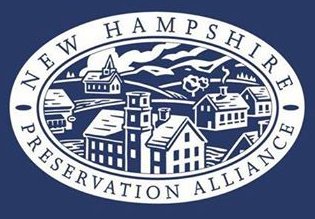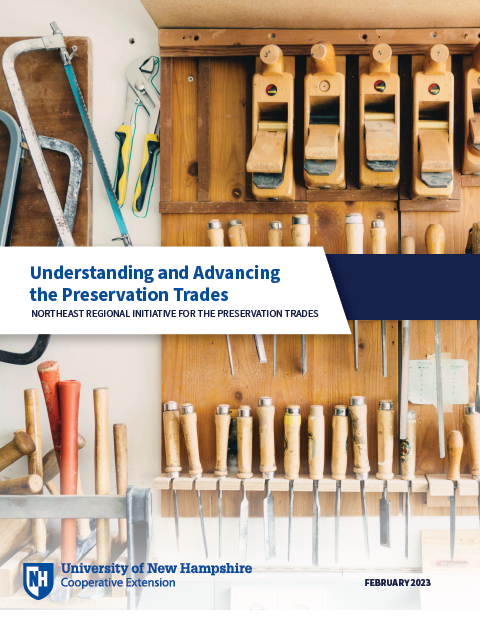Research on Preservation and Restoration Building Trades Reveals Worker Shortages in the Northeast and Highlights Opportunities for Workforce Development
The N.H. Preservation Alliance Teams up with UNH Cooperative Extension and Colleagues in NY, VT, and ME to Understand and Address the Issue of the Current Shortage of Skilled Building Tradespeople in our Region
A new research report sponsored by the N.H. Preservation Alliance with three other Northeast statewide preservation organization, documents a growing crisis in the building trades and identifies promising trends and concepts to help reverse the decline.
Across the Northeast, a growing number of older homes and historic community landmarks are in dire need of maintenance and repair or rehabilitation and can’t get it. The craftspeople who have specialized knowledge in preservation and restoration techniques and an in-depth understanding of how to work with traditional materials are dwindling. A new research report documents a growing crisis in the building trades and identifies promising trends and concepts to help reverse the decline. The report is available to download for free.
This revealing report was prepared by the University of New Hampshire Cooperative Extension for a collaboration of four statewide historic preservation non-profit organizations. The N.H. Preservation Alliance, Preservation Trust of Vermont, Maine Preservation, and the Preservation League of New York State sponsored the study and are committed to working with others to find solutions. They have named their collaboration the Northeast Regional Initiative for the Preservation Trades.
Critical Shortages in the Building Trades
The completed report reveals a lack of skilled building tradespeople in the Northeast. Key findings of the study’s workforce survey include:
There are severe workforce shortages in plastering, masonry, carpentry, materials conservation, decorative finishes, windows, and iron work.
More than one third of survey respondents reported that their clients must wait a year or more for their services.
75% of respondents believe the demand for preservation trades is growing.
88% of respondents feel that training programs could play a greater role in recruitment and workforce development.
93% of survey respondents agree that young people lack knowledge about career possibilities in preservation trades.
Careers in the Building Trades are Considered Highly Rewarding
However, the survey also found that these careers can be highly rewarding: 96% of tradespeople who responded to the workforce survey reported satisfaction in their careers.
Reasons for Shortages in the Building Trades
The N.H. Preservation Alliance, Preservation Trust of Vermont, Maine Preservation, and the Preservation League of New York State. plan to work collaboratively to develop action plans, engage new business and educational partners, and build awareness and enthusiasm for these notably creative, highly-rewarding, hands-on career paths. Educational programming, such as the Preservation Alliance and Sanborn Mill Farm’s Old Building and Trades Fair in 2022, is one strategy.
Several factors account for these workforce shortages. The current workforce is aging and retiring, and new people are not coming to replace them. Opportunities for youth to participate in “shop” classes during their schooling are diminishing. As a result, many young people lack the basic knowledge that could set them up to be interested and successful in these careers. In recent decades, the study found, youth have been encouraged to attend four-year colleges, and trade career choices have commonly been stigmatized or less favored. Furthermore, students who do participate in trades education, such as through Career and Technical Education (CTE) programs, are often directed toward new construction without learning about the restoration of older structures.
Positive Trends Towards the Future of the Building Trades
While some of the findings may seem to paint a bleak picture, there are positive signs. Trades are increasingly valued for the skills they require, and traditionally under-represented groups like women are more readily welcomed into the ranks. Preservation trades professionals note that a variety of educational pathways, including college education, trade schools, and apprenticeships, can lead to successful preservation trades careers. These jobs can be particularly engaging due to their creative qualities and connections to academic disciplines like history, engineering, chemistry, and art. Ample mentorship and access to hands-on, field-based learning experiences are critical elements of trainee development.
Preservation Trades Professionals Reactions to the Study
and Reflections on Working in the Field
Long-time old barn expert and former Preservation Alliance board member Ian Blackman offers these sentiments of why he’s worked in the field: “I love preservation work because of the variety of the skills you need to do the job, and because each project brings new challenges. When you are working on a barn that was built in the 1700s, you are repairing timbers from trees that were saplings in the 1500s. The connection to the landscape and the people that worked it is very rewarding.”
93% of survey respondents agree that young people lack knowledge about career possibilities in preservation trades, but the study points to outstanding examples of mentoring and training like the Canaan (VT) High School program, showed here at a project in Colebrook, NH.
Arron Sturgis, owner of Preservation Timber Framing, Inc. and a current board member of the N.H. Preservation Alliance and Maine Preservation, is one tradesperson who has been actively engaged with preservation organizations to help expand the workforce. Sturgis believes that this recent research “provides a basis for action that will create really good jobs and much needed aid to homeowners and historic commercial ventures.”
Jennifer Goodman, Executive Director of N.H. Preservation Alliance, is looking forward to working with partners to put this research into action. "Tradespeople's reports of high job satisfaction, positive trends like the trades becoming more welcoming to women, and strong examples of existing informal and formal mentorships and training that could grow make addressing this huge challenge feel more personal and do-able," said Goodman.
Next Steps to Nurture Growth in the Building Trades in New England
Understanding how to build upon the acknowledged strengths of these career paths and foster a robust future workforce are key concerns of the N.H. Preservation Alliance, Preservation Trust of Vermont, Maine Preservation, and the Preservation League of New York State. These organizations plan to work collaboratively to develop action plans, engage new business and educational partners, and build awareness and enthusiasm for these notably creative, highly-rewarding, hands-on career paths. Several promising partnerships are already underway, such as apprenticeship and fellowship programs for youth and new professionals.
The full research report, Understanding and Advancing the Preservation Trades, provides an overview of the current status of these professions in the Northeast, and offers a wealth of insights from tradespeople, educators, workforce development professionals, and preservation specialists. These perspectives together inform a variety of recommended actions suitable for individual practitioners, businesses, nonprofits, training programs, and other stakeholders who aim to strengthen the preservation trades workforce.
Funders of the report include the Moe Family Fund for Statewide and Local Partners through the National Trust for Historic Preservation, The 1772 Foundation, and other donors.
Have questions or ideas? Want to help? Email projects@nhpreservation.org with “trades” in the message line.



